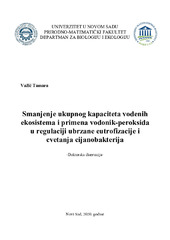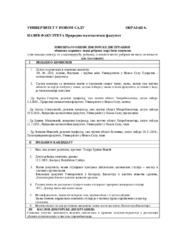Smanjenje ukupnog kapaciteta vodenih ekosistema i primena vodonik-peroksida u regulaciji ubrzane eutrofizacije i cvetanja cijanobakterija
Decrease of the total capacity of aquatic ecosystems and the application of hydrogen peroxide in the regulation of accelerated eutrophication and blooming of cyanobacteria
| dc.contributor.advisor | Svirčev, Zorica | |
| dc.contributor.other | Simeunović, Jelica | |
| dc.contributor.other | Svirčev, Zorica | |
| dc.contributor.other | Miljanović, Branko | |
| dc.contributor.other | Nikolić, Ljiljana | |
| dc.creator | Važić, Tamara | |
| dc.date.accessioned | 2021-02-25T14:53:28Z | |
| dc.date.available | 2021-02-25T14:53:28Z | |
| dc.date.issued | 2020-11-16 | |
| dc.identifier.uri | https://www.cris.uns.ac.rs/DownloadFileServlet/Disertacija159947530056171.pdf?controlNumber=(BISIS)114987&fileName=159947530056171.pdf&id=16586&source=NaRDuS&language=sr | sr |
| dc.identifier.uri | https://www.cris.uns.ac.rs/record.jsf?recordId=114987&source=NaRDuS&language=sr | sr |
| dc.identifier.uri | https://www.cris.uns.ac.rs/DownloadFileServlet/IzvestajKomisije15994753120904.pdf?controlNumber=(BISIS)114987&fileName=15994753120904.pdf&id=16587&source=NaRDuS&language=sr | sr |
| dc.identifier.uri | /DownloadFileServlet/IzvestajKomisije15994753120904.pdf?controlNumber=(BISIS)114987&fileName=15994753120904.pdf&id=16587 | |
| dc.identifier.uri | https://nardus.mpn.gov.rs/handle/123456789/17973 | |
| dc.description.abstract | Dugoročno rešenje problema povećanog ukupnog kapaciteta vodenih ekosistema, posledičnog ubraznja eutrofizacije i cvetanja potencijalno toksičnih cijanobakterija podrazumeva smanjenje priliva nutrijenata, kao i eliminaciju viška nutrijenata iz samog vodenog ekosistema, naročito azota i fosfora. Kao rešenje ovog problema se predlaže istovremena upotreba seta poznatih alternativnih metoda, označenih zajedničkim nazivom ekomanipulacija, koji uključuje: mehaničko uklanjanje makrofita i biomase cijanobakterija, upotreba plutajućih ostrva, masovno izlovljavanje ribe. Izvršena je procena mehaničkog uklanjanja trske (Phragmites australis) u kontekstu zaštite i prečišćavanja vodenih ekosistema i kao energetskog resursa na teritoriji Vojvodine. Procenjeno je da je oko 0,98% površine Vojvodine pokriveno trskom sa prosečnim prinosom od oko 2 kg/m 2 , odnosno oko 20 t/ha. Košenjem i uklanjanjem nadzemne biomase bi moglo da se ukloni do 333,20 kg/ha azota i 25,20 kg/ha fosfora. Pored povoljnih karakteristika trske kao energetske sirovine, troškovi obrade biomase trenutno prevazilaze potencijalnu zaradu, zbog čega ova makrofita ima veći značaj na lokalnom nivou. Ispitivana je efikasnost usvajanja nutrijenata direktno iz vodenog stuba putem uklanjanja nadzemne biomase trske iz PPES jedinica, kao i testiranje održivosti čitavog PPES sistema. Iako uklanjanje oko 800 g nadzemne biomase trske može smanjiti ukupni kapacit do izvesne mere, dodatne vrednosti upotrebe PPES sistema poput usvajanja toksičnih materija, korisne upotrebe plastičnog otpadnog materijala, proizvodnje biljne biomase ovu metodu čini značajnim delom sistema ekomanipulacija. Korišćenjem puferskog sistema ekoremedijacije baziranog na iznošenju biomaske trske se takođe obezbeđuje smanjenje ukupnog kapaciteta. Na taj način se može postići kontrola ubrzane eutrofizacije na četiri funkcionalna nivoa u dinamici ekosistema, koji podrazumevaju: sprečavanje priliva materija u vodeni ekosistem iz spoljašnje sredine izgradnjom mokrih polja, povećanje procesa razgradnje uvođenjem aeracije, prečišćavanje mulja ili efluenta i manipulacija trskom u priobalju. Procenjena je efikasnost mehaničkog uklanjanja toksične biomase cijanobakterije vrste Planktothrix rubescens iz akumulacije Vrutci. Rezultati ukazuju na efikasnost ove metode u smanjenju ukupnog kapaciteta, međutim samo tokom perioda cvetanja. Ispitivana je sposobnost 14 sojeva bakterija, izolovanih iz sakupljenje površinske skrame P. rubescens, da degradiraju cijanotoksin mikrocistin-LR. Degradacija toksina posle devet dana nije detektovana, što je moglo da bude posledica dužeg perioda adaptacije (lag faze) koji je bio potreban da bi se aktivirali odgovarajući geni i enzimski putevi odgovorni za biodegradaciju. Ispitivana je efikasnost metode masovnog izlovljavanja babuške (Carassius gibelio) iz sektora IV jezera Palić. Na osnovu količine iznete biomase tokom probnog izlova 2016. godine i poznatog hemijskog sastava, procenjeno je da je masovnim izlovom moguće ukloniti značajnu količinu nutrijenata na nivou čitavog jezera. Uprkos efikasnosti i pratećim povoljnim promenama u ekosistemu, zbog složenosti lanca ishrane i uopšte jezerskog ekosistema se preporučuje primena pridruženih metoda biomanipulacije ribljom fondom, kao i drugih metoda ekomanipulacije. Ispitivani su cijanocidni efekti vodonik-peroksida, kao dodatne metode u procesu revitalizacije jezera. Uzorci vode iz srpskih jezera Bečmenska bara (sektor Bečmen 3) i jezera Ludaš i finskog jezera Köyliönjärvi su bili tretirani različiti koncentrcijama vodonik-peroksida. Analize sadržaja hlorofila a i intracelularnih mikrocistina, indeksa vijabilnosti pokretnih grupa necijanobakterijskog fitoplanktona, zooplanktona i osetljivosti makroinvertebrata, ukazale su na mogućnost efikasne selektivne supresije cijanobakterija ravnomernim apliciranjem 2-5 mg/L vodonik-peroksida. Uočena je različita osetljivost kod ispitivanih grupa organizama na dejstvo agensa, zbog čega je u primeni ove metode neophodan dodatni oprez. Da bi se obezbedio uspešan proces revitalizacije jezera, važno je da se metode ekomanipulacije prilagode stanju i karakteristikama jezera, a da se vodonik-peroksid koristi samo u slučaju potrebe. Na takav načinmože nesmetano da se odvija dugotrajan proces revitalizacije. Zbog složenosti problema povećanja ukupnog kapaciteta, ubrzane eutrofizacije i procesa revitalizacije, neophodno je obezbediti multidisciplinarni pristup, pripremu akcionog plana i sprovođenje metoda pod strogo kontrolisanim uslovima. | sr |
| dc.description.abstract | A long-term solution for the problem of increased total capacity in water ecosystems, and consequently accelerated eutrophication and potentially toxic cyanobacterial blooms, implies the restriction of nutrient inputs to the water bodies, as well as elimination of additional nutrients directly from water ecosystems,especially nitrogen and phosphorus. As a solution for this problem, it is proposed to simultaneously use a set of alternative methods, entitled as ecomanipulation, that include: mechanical removal of macrophytes and cyanobacterial biomass, floating islands, extensive fishing. Mechanical removal of Common reed (Phragmites australis) was estimated for the purpose of protection and purification of water ecosystems, as well as an energy source in the Vojvodina region. It was estimated that about 0,98% of the Vojvodina region is covered with common reed, with an average yield of 2 kg/m2, eg about 20 t/ha. By harvesting and removing of above-ground biomass, it would be possible to remove up to 333.20 kg/ha of nitrogen and 25.20 kg/ha of phosphorus. Besides favorable characteristics as an energy source, the cost of biomass processing currently exceeds potential revenues, hence this macrophyte is more significant at the local level. The efficiency of nutrient absorption directly from the water column by removal of the reed biomass incorporated in the PPES unites was examined, as well as testing the sustainability of the whole PPES system. Although removal of about 800 g of the above-ground reed biomass can decrease the total capacity up to a certain extent, additional values of PPES usage like the uptake of toxic compounds,useful use of plastic waste material, production of plant biomass makes this method important part of ecomanipulation system. The use of a buffer system of ecoremediation based on the removal of reed biomass also provides a reduction in total capacity. In this way, control of accelerated eutrophication can be achieved at four functional levels in ecosystem dynamics, which include: preventing the inflow of matter into the aquatic ecosystem from the external environment by building artificial wetlands, increasing the decomposition process by introducing aeration, sludge or effluent treatment, and reed manipulation in the coastal area. The efficiency of mechanical removal of toxic biomass of cyanobacteria Planktothrix rubescens from the Vrutci reservoir was estimated. The results indicate the effectiveness of this method in reducing the total capacity, but only during the blooming period. The ability of 14 bacterial strains, isolated from collected P. rubescens surface scum, to degrade cyanotoxin microcystin-LR was investigated. Degradation of toxin after nine days was not detected, which could be a consequence of a longer period of adaptation (lag phase) that was needed for activation of certain genes and enzyme pathways responsible for biodegradation. The efficiency of extensive fishing of Prussian carp (Carassius gibelio) from the sector IV of Lake Palić was investigated. Based on the amount of removed biomass during the trial catch in 2016, and the known chemical composition of fish, it was estimated that extensive fishing can remove a significant amount of nutrients at the level of the entire lake. Despite the efficiency and following favorable changes in the ecosystem, due to the complexity of the food chain and the lake ecosystem in general, the use of associated methods of biomanipulation with fish stock, as well as other methods of ecomanipulation, is recommended. The potential of cyanocidal effects of hydrogen peroxide, as an auxiliary method in the process of lake revitalization, was investigated. Water samples from Serbian lakes Bečmenska bara (sector Bečmen 3) and Lake Ludaš, as well as Finnish Lake Köyliönjärvi, were treated with different concentrations of hydrogen peroxide. Analysis of contents of chlorophyll a and intracellular microcystins, viability index of non-cyanobacterial moving phytoplankton, zooplankton, and sensitivity of macroinvertebrate indicated the possible efficiency of the selective suppression of cyanobacteria by uniform application of 2-5 mg/L of hydrogen peroxide in the water column. Examined groups of organisms expressed different sensitivity towards the applied concentrations of the agent, which is the reason for additional caution in the application of this method.In order to provide successful lake revitalization, it is important to adjust methods of ecomanipulation to the condition and characteristics of the lake, and also to use hydrogen peroxide only when it is necessary.In this way, the long recovery process can proceed smoothly. Due to the complexity of the problem of increased total capacity, accelerated eutrophication, and the process of revitalization, it is necessary to provide a multidisciplinary approach, preparation of an action plan and implementation of methods under strictly controlled conditions. | en |
| dc.language | sr (latin script) | |
| dc.publisher | Универзитет у Новом Саду, Природно-математички факултет | sr |
| dc.relation | info:eu-repo/grantAgreement/MESTD/Basic Research (BR or ON)/176020/RS// | |
| dc.rights | openAccess | en |
| dc.rights.uri | https://creativecommons.org/licenses/by-nc/4.0/ | |
| dc.source | Универзитет у Новом Саду | sr |
| dc.subject | Ukupni kapacitet | sr |
| dc.subject | total capacity | en |
| dc.subject | eutrophication | en |
| dc.subject | cyanobacteria | en |
| dc.subject | lakes | en |
| dc.subject | ecomanipulation | en |
| dc.subject | hydrogen peroxide | en |
| dc.subject | revitalization | en |
| dc.subject | eutrofizacija | sr |
| dc.subject | cijanobakterije | sr |
| dc.subject | jezera | sr |
| dc.subject | ekomanipulacija | sr |
| dc.subject | vodonik-peroksid | sr |
| dc.subject | revitalizacija | sr |
| dc.title | Smanjenje ukupnog kapaciteta vodenih ekosistema i primena vodonik-peroksida u regulaciji ubrzane eutrofizacije i cvetanja cijanobakterija | sr |
| dc.title.alternative | Decrease of the total capacity of aquatic ecosystems and the application of hydrogen peroxide in the regulation of accelerated eutrophication and blooming of cyanobacteria | en |
| dc.type | doctoralThesis | en |
| dc.rights.license | BY-NC | |
| dcterms.abstract | Свирчев, Зорица; Николић, Љиљана; Симеуновић, Јелица; Свирчев, Зорица; Миљановић, Бранко; Важић, Тамара; Смањење укупног капацитета водених екосистема и примена водоник-пероксида у регулацији убрзане еутрофизације и цветања цијанобактерија; Смањење укупног капацитета водених екосистема и примена водоник-пероксида у регулацији убрзане еутрофизације и цветања цијанобактерија; | |
| dc.identifier.fulltext | https://nardus.mpn.gov.rs/bitstream/id/68733/IzvestajKomisije.pdf | |
| dc.identifier.fulltext | https://nardus.mpn.gov.rs/bitstream/id/68726/Disertacija.pdf | |
| dc.identifier.rcub | https://hdl.handle.net/21.15107/rcub_nardus_17973 |



